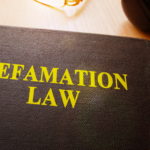Australia: The Defamation Capital of the World

The high-profile defamation proceedings between Hollywood star Johnny Depp and his former wife, actor Amber Heard, was followed by millions around the globe.
The story so far
Unless you’ve been living under a rock, you’ll know Mr Depp commenced civil proceedings again Ms Heard over statements contained in the latter’s opinion piece published in the Washington Post on 18 December 2018.
While the article not expressly identify Mr Depp, the requirement of identification in defamation was – according to Depp’s legal team – established by:
- Public knowledge of their relationship,
- The fact Heard applied for an ex parte (meaning in the absence of one or more parties) restraining order two years prior,
- The fact the order was well-publicised and painted Depp as a domestic violence abuser, and
- Heard’s stated in the article that she had spoken out about sexual violence two years prior.
Mr Depp sought $50 million in damages over three statements contained in the opinion piece, while Ms Heard filed a counter-claim in the sum of $100 million over three statements made by Depp’s former attorney (lawyer), Adam Waldman, to the Daily Mail newspaper in the United Kingdom which, Heard asserted, were untrue and damaging.
The statements
The three statements that Depp claimed to be defamatory were:
- “I spoke up against sexual violence — and faced our culture’s wrath. That has to change”,
- “Then two years ago, I became a public figure representing domestic abuse, and I felt the full force of our culture’s wrath for women who speak out”, and
- “I had the rare vantage point of seeing, in real time, how institutions protect men accused of abuse.”
The three statements made by Mr Waldman which Heard claimed amounted to defamation by Mr Depp were:
- “Amber heard and her friends in the media used fake sexual violence allegations as both a sword and shield depending on their needs. They have selected some of her sexual violence hoax fact as a sword inflicting them on the public and Mr Depp”,
- “Quite simply this was an ambush, a hoax. They set Mr Depp up by calling the cops but the first attempt didn’t do the trick… The officers came to the penthouses, thoroughly searched and interviewed, and left after seeing no damage to face or property. So Amber and her friends spilled a little wine and roughed the place up, got their stories straight under the direction of a lawyer and publicist, and then placed a second call to 911”, and
- “We have reached the beginning of the end of Ms Heard’s abuse hoax against Johnny Depp”.
Free speech
Unlike in Australia, free speech is guaranteed across the United States pursuant to the First Amendment to the nation’s constitution.
For that reason, a very high bar is set for the imposition of prohibitions against dangerous and damaging speech, such as hate speech and defamation.
So, what did the parties have to prove?
That being so, Depp and Heard had to establish multiple matters ‘by the greater weight of the evidence’ to succeed in their claims.
The phrase ‘by the greater weight of of the evidence’ is the equivalent to ‘on the balance of probabilities’, which is used in Australia. It means the claimant must prove the asserted fact or circumstance is more likely than not; in other words, there is more than a 50% chance it is correct.
To succeed in establish that a statement in the op-ed was defamatory, the jurors had to answer each of the following questions in the affirmative:
- Did Ms Heard make the statement?
- Does the statement imply or insinuate anything about Mr Depp?
- Was the statement seen by anyone other than Mr Depp?
- Did the statement convey a defamatory implication to someone who saw it other than Mr Depp?
- Is an implication or insinuation about Mr Depp in the statement false?
- Did Ms Heard make the statement with actual malice?
- If Mr Depp is entitled to recover, what is the amount of Mr Depp’s damages?
The requirement of ‘actual malice’ applies to those considered ‘public figures’, and there was no issue at trial that both Depp and Heard were public figures at the time.
To establish that a statement by Mr Waldman was defamatory, the jurors had to answer each of the following questions in the affirmative:
- Did Mr Waldman, while acting as an agent for Mr Depp, make the statement?
- Is the statement about Ms Heard?
- Was the statement seen by someone other than Ms Heard?
- Is the statement false?
- Was the statement made with actual malice?
- If Ms Heard is entitled to recover, what is the amount of Ms Heard’s damages?
The verdict
After hearing all of the evidence, judge’s directions on the law and closing statements, the jury delivered the following unanimous verdicts:
Claim by Depp
All questions are answered in the affirmative in respect of all three statements.
In other words, statements 1, 2 and 3 each amounted to defamation by Ms Heard.
Claim by Heard
Statement 1 did not amount to defamation by Mr Depp.
Statement 2 did amount to defamation by Mr Depp as the principal of his agent, attorney Mr Waldman, who made the statement.
Statement 3 did not amount to defamation.
Damages
The jury awarded Mr Depp USD$10 million in actual damages.
The jury awarded Mr Depp $5 million in ‘punitive damages’; in other words, damages to punishment for her conduct.
It should be noted that the limit for punitive damages in Virginia, where the trial occurred, is $350,000 which means Mr Depp will only be entitled to that part of the punitive damages.
The jury awarded Ms Heard $2 million in actual damages.
The jury did not award Ms Heard punitive damages.
The upshot
The judgment was clearly a resounding victory for Mr Depp, a vindication of his assertion that he did not engage in physical or sexual violence during their relationship and that Ms Heard’s statements were untrue and that she acted with actual malice in making them.
In that regard, it is notable that the only assertion found to be defamatory – a statement for which he is responsible in the law due to the principal/agent relationship with his attorney Mr Waldman whether he knew about it or not – was that Ms Heard and her friend essentially “set Mr Depp up by calling the cops”, then after police left “spilled a little wine and roughed the place up” before calling police again.
The statement was not about sexual or physical violence, and the statements made by Mr Waldman about using “fake sexual violence allegations as both a sword and shield” and (statement 1) and “Ms Heard’s abuse hoax against Johnny Depp” (statement 3) were found not to be defamatory – the inference in the context of the trial being they were not untrue statements.
It appears the future of the woman who not only put herself to be a victim of domestic violence, but a domestic violence ambassador, and who falsely claimed to have donated all of the USD$7 million divorce settlement paid to her by Mr Depp to two charitable foundations is on shaky grounds.
The publicity surrounding the case may also put a dent in the #MeToo movement, potentially making it less likely that actual victims of domestic and sexual violence will speak out about or report the crimes, and that those who do raise their voices will be believed.
What about Australia?
As stated, the constitutional protection afforded to free speech by the first amendment to the United States constitution makes it necessary to set a very high bar for limitations to that right to be considered lawful.
The situation here in Australia is very different: in fact, we are the only Western Democracy not to have a national Bill or Charter of rights, and only an extremely limited freedom of political communication has been implied into the Australian Constitution.
For that reason, laws can be passed which limit free speech without impinging on any entrenched protection.
The laws of defamation are just one of those limitations, and these are broadly consistent across all Australian jurisdictions.
Australia: the most plaintiff-friendly defamation on earth
The ease with which plaintiffs across Australia are able to establish defamation and the limited defences available have resulted in our nation being labelled ‘the defamation capital of the world’.
In fact just yesterday, the Federal Court of Australia awarded former New South Wales deputy Premier, John Barilaro, $715,000 in damages plus legal costs over videos posted by political satirist Jordan Shanks of the Friendlyjordies which suggested the politician was a corrupt conman who committed perjury, and referred both Shanks and Google for potential contempt of court charges for allegedly making baseless claims against Barilaro’s lawyers.
Under the Defamation Act 2005 (NSW) – which is substantially replicated in other jurisdictions – plaintiffs need only establish three matters:
-
Publication
Material must be published (which includes orally communicated) to at least one person other than the party who was allegedly defamed.
The publication can occur orally or in writing, whether in print, by way of digital communication or otherwise, but it must be comprehensible.
-
Identification
The material must identify the allegedly defamed person either directly or indirectly, or be capable of doing so.
-
Defamatory meaning
The material must be ‘defamatory’ to the ‘ordinary, reasonable’ person, which means it must be likely to:
- cause the person to be shunned, shamed or avoided by others;
- adversely affect the reputation of the person in the minds of right-thinking members of society; or
- damage to the person’s professional reputation by suggesting a lack of qualifications, skills, knowledge, capacity, judgment or efficiency in his or her trade, business or profession.
If these three matters are estabished, the onus then shifts to the defendant to prove on the balance of probabilities that a defence to the defamation exists.
And while there are several such defences, the shift in the onus of proof can make them difficult to establish.
If a defence is not made out, the next step is to determine the quantum (amount) of damages, including any aggravated compensatory damages (known as ‘punitive damages’ in the US).
Defences to defamation
The legal defences to defamation are:
Part 4, Division 2 of the Defamation Act lists the statutory defences, which section 24 makes clear are additional to any others available under the law.
The statutory defences are:
-
Justification
Section 25 of the Act states that ‘[i]t is a defence to the publication of defamatory matter if the defendant proves that the defamatory imputations carried by the matter of which the plaintiff complains are substantially true.
-
Contextual truth
Section 26 provides a defence where the defendant proves that:
- the matter carried, in addition to the defamatory imputations of which the plaintiff complains, one or more other imputations (“contextual imputations”) that are substantially true, and
- the defamatory imputations do not further harm the reputation of the plaintiff because of the substantial truth of the contextual imputations.
-
Absolute privilege
Section 27 sets out the defence of absolute privilege, which relates to material published in the course of the proceedings of a parliamentary body, including (but not limited to):
- documents by order, or under the authority, of the body, and
- debates and proceedings of the body by or under the authority of the body or any law, and
- evidence before the body, and
- presentations or submissions of documents to the body.
The defence also extends material published in the course of the proceedings of an Australian court or Australian tribunal, including (but not limited to):
- documents filed or lodged with, or otherwise submitted to, the court or tribunal (including any originating process), and
- evidence before the court or tribunal, and
- any judgment, order or other determination of the court or tribunal.
The defence further extends to material which would attract absolute privilege in another Australian jurisdiction.
-
Public documents
Section 28 provides a defence to publishing:
- a public document or a fair copy of a public document, or
- a fair summary of, or a fair extract from, a public document.
A public document is defined as:
- any report or paper published by a parliamentary body, or a record of votes, debates or other proceedings relating to a parliamentary body published by or under the authority of the body or any law, or
- any judgment, order or other determination of a court or arbitral tribunal of any country in civil proceedings and including:
- any record of the court or tribunal relating to the judgment, order or determination or to its enforcement or satisfaction, and
- any report of the court or tribunal about its judgment, order or determination and the reasons for its judgment, order or determination, or
- any report or other document that under the law of any country:
- is authorised to be published, or
- is required to be presented or submitted to, tabled in, or laid before, a parliamentary body, or
- any document issued by the government (including a local government) of a country, or by an officer, employee or agency of the government, for the information of the public, or
- any record or other document open to inspection by the public that is kept:
- by an Australian jurisdiction, or
- by a statutory authority of an Australian jurisdiction, or
- by an Australian court, or
- under legislation of an Australian jurisdiction, or
- any other document issued, kept or published by a person, body or organisation of another Australian jurisdiction that is treated in that jurisdiction as a public document under a provision of a law of the jurisdiction corresponding to this section.
The section states that a defence of publishing a public document can only be defeated if the plaintiff proves the defamatory material was not published honestly for the information of the public or the advancement of education.
-
Fair reporting of proceedings of public concern
Section 29 makes it a defence where the defendant establishes that the defamatory material:
- was, or was contained in, an earlier published report of proceedings of public concern, and
- was, or was contained in, a fair copy of, a fair summary of, or a fair extract from, the earlier published report, and
- the defendant had no knowledge that would reasonably make the defendant aware that the earlier published report was not fair.
Proceedings of public concern is defined any proceedings:
- in public of a parliamentary body, or
- in public of an international organisation of any countries or of the governments of any countries, or
- in public of an international conference at which the governments of any countries are represented, or
- in public of:
- the International Court of Justice, or any other judicial or arbitral tribunal, for the decision of any matter in dispute between nations, or
- any other international judicial or arbitral tribunal, or
- in public of a court or arbitral tribunal of any country, or
- in public of an inquiry held under the law of any country or under the authority of the government of any country, or
- in public of a local government body of any Australian jurisdiction, or
- of a learned society, or of a committee or governing body of the society, under its relevant objects, but only to the extent that the proceedings relate to a decision or adjudication made in Australia about:
– a member or members of the society, or
– a person subject by contract or otherwise by law to control by the society, or
- of a sport or recreation association, or of a committee or governing body of the association, under its relevant objects, but only to the extent that the proceedings relate to a decision or adjudication made in Australia about:
- a member or members of the association, or
- a person subject by contract or otherwise by law to control by the association, or
- of a trade association, or of a committee or governing body of the association, under its relevant objects, but only to the extent that the proceedings relate to a decision or adjudication made in Australia about:
- a member or members of the association, or
- a person subject by contract or otherwise by law to control by the association, or
- of a public meeting (with or without restriction on the people attending) of shareholders of a public company under the Corporations Act 2001 of the Commonwealth held anywhere in Australia, or
- of a public meeting held anywhere in Australia if the proceedings relate to a matter of public interest, including the advocacy or candidature of a person for public office, or
- of an ombudsman of any country if the proceedings relate to a report of the ombudsman, or
- in public of a law reform body of any country, or
- conducted by, or proceedings of, a person, body or organisation of another Australian jurisdiction that are treated in that jurisdiction as proceedings of public concern under a provision of a law of the jurisdiction corresponding to this section.
-
Qualified privilege
Section 30 makes it a defence where the defendant proves that:
- the recipient of the information has an interest or apparent interest in having information on some subject, and
- the matter is published to the recipient in the course of giving to the recipient information on that subject, and
- the conduct of the defendant in publishing that matter is reasonable in the circumstances.
In determining whether the defendant’s conduct is reasonable, the court is to consider:
- the public interest in the matter, and
- whether the material relates to the performance of public functions, and
- the seriousness of any defamatory imputation, and
- whether the material distinguishes between suspicions, allegations and proven facts, and
- whether it was in the public interest to publish the matter expeditiously, and
- the nature of the business environment in which the defendant operates, and
- the integrity of the sources of the information;
- whether the substance of the material is person’s side of the story and, if not, whether a reasonable attempt was made by the defendant to obtain and publish a response from the person, and
- any other steps taken to verify the matter published, and
- any other circumstances that the court considers relevant.
The section provides that a recipient only has an apparent interest in the information on some subject if at the time of the publication in question, the defendant believes on reasonable grounds that the recipient has that interest.
-
Honest opinion
Section 31 provides a defence where the defendant, or an employee or agent of the defendant, or commentator, establishes that:
- the matter was an expression of opinion of the defendant rather than a statement of fact, and
- the opinion related to a matter of public interest, and
- the opinion is based on proper material.
Proper material is that which:
- is substantially true, or
- was published under absolute or qualified privilege, or
- was published in a context that attracted the protection of a defence under this section, or the defence of public documents or fair reporting.
The section further states that an opinion does not cease to be based on proper material only because some of the material on which it is based is such if the opinion might reasonably be based on such of the material as is proper material.
A defence of honest opinion is only defeated if the plaintiff proves that: the opinion was not honestly held by the defendant, or any employee or agent or the commentators as the case may be, at the time the defamatory matter was published,
-
Innocent dissemination
Section 32 makes it a defence where it is proved the defendant:
- published the material merely in the capacity, or as an employee or agent, of a subordinate distributor, and
- neither knew, nor ought reasonably to have known, that the matter was defamatory, and
- lack of knowledge was not due to any negligence on the part of the defendant.
A subordinate distributor is someone who:
- was not the first or primary distributor of the matter, and
- was not the author or originator of the matter, and
- did not have any capacity to exercise editorial control over the content of the material or publication thereof before it was first published.
The section provides that a person is not the first or primary distributor merely because he or she was involved in the capacity of a:
- bookseller, newsagent or news-vendor, or
- librarian, or
- wholesaler or retailer of the matter, or
- provider of postal or similar services by means of which the matter is published, or
- broadcaster of a live programme,
Or the provider of services consisting of the:
- processing, copying, distributing or selling of any electronic medium, or
- operation of, or the provision of any equipment, system or service, by means of which the matter is retrieved, copied, distributed or made available in electronic form, or
Or an operator of, or a provider of access to, a communications system by means of which the matter is transmitted, over whom the operator or provider has no effective control, or
Or a person who, on the instructions or at the direction of another person, prints or produces, reprints or reproduces or distributes the matter for or on behalf of that other person.
-
Triviality
Section 33 provides a defence where the defendant proves that the circumstances of publication were such that the plaintiff was unlikely to sustain any harm.
10. Responsible communication in the public interest
Introduced in 2021, section 29A provides a defence where the publication concerns an issue of public concern and the defendant reasonably believed it to be in the public interest.
Time limit
Section 14B of the Limitation Act 1969 (NSW) provides that ‘an action on a cause of action for defamation is not maintainable if brought after the end of a limitation period of 1 year running from the date of the publication of the matter complained of.’
However, section 56A(2) allows a court to extend that period to up to 3 years from the date of publication, ‘if satisfied that it was not reasonable in the circumstances for the plaintiff to have commenced an action in relation to the matter complained of within 1 year from the date of the publication’.
Parties that cannot be defamed
Under section 9 of the Defamation Act, companies with 10 or more employees or which are formed for something other than financial gain cannot sue for defamation.
Section 10 precludes anyone from asserting, continuing or enforcing a cause of action for defamation in respect of a deceased person, or from suing the estate of a deceased person.
Offers to make amends
Part 3, Division 1 of the Act sets out a range of rules for resolving civil defamation disputes without litigation.
The part provides mechanisms for offering to make amends without resorting to legal proceedings, and makes clear that any such offers, or admissions made therein, are not admissible in any ensuing litigation.






